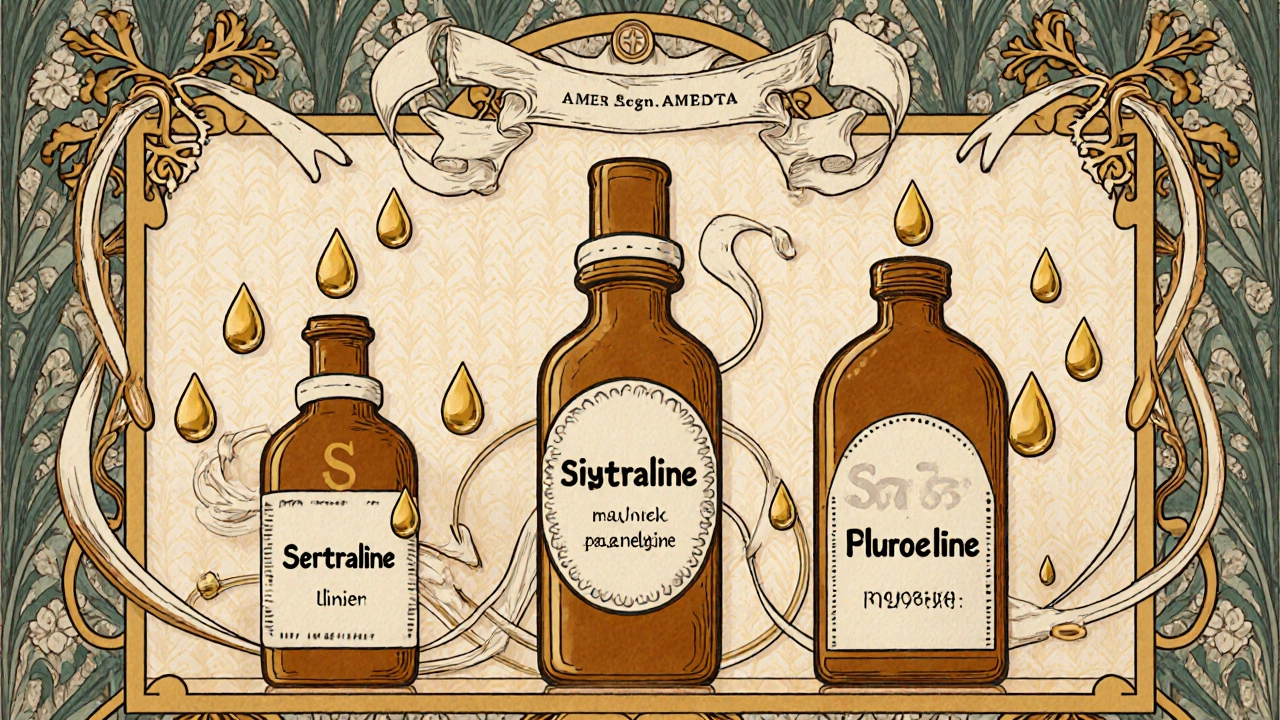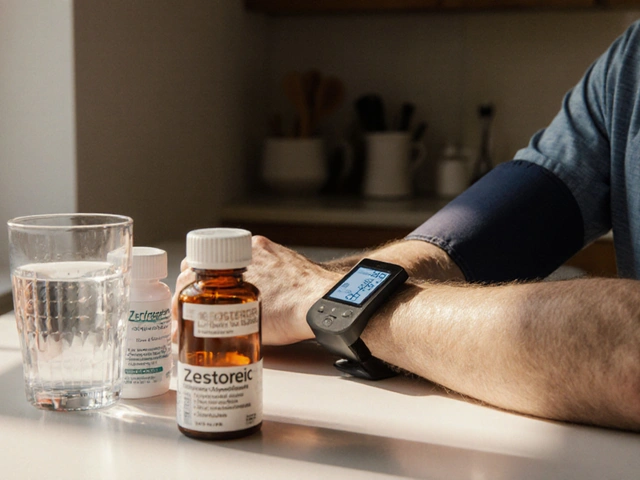Antidepressant Breastfeeding Compatibility Checker
Antidepressant Safety Checker
Check the safety of antidepressants while breastfeeding based on Relative Infant Dose (RID) and clinical recommendations. Data based on CDC, AAP, and ACOG guidelines.
Select a medication to see safety information
Understanding Relative Infant Dose (RID)
RID is the ratio of drug exposure in the infant to the mother's dose. It's calculated as: (Infant's daily exposure in milk / Mother's daily dose) × 100%
The general guideline is that an RID of less than 10% is considered compatible with breastfeeding. Lower values indicate safer options.
When a new mother battles the dark cloud of postpartum depression (PPD), the last thing she wants to feel is torn between her own mental health and her baby’s safety while nursing. The good news? Most antidepressants pose a very low risk to a breastfed infant, and the benefits of treating PPD usually outweigh the theoretical hazards. This guide walks you through the science, the safest drug choices, and a step‑by‑step plan to keep both mom and baby thriving.
What is postpartum depression and why does treatment matter?
Postpartum Depression is a mood disorder that affects roughly one in eight mothers after giving birth, causing persistent sadness, anxiety, and difficulty bonding with the infant. Unlike the brief “baby blues,” PPD lasts longer than two weeks and can impair daily functioning (CDC, 2023). Untreated PPD raises the risk of poor infant nutrition, less responsive caregiving, and even long‑term developmental issues. That’s why major bodies like the AAP, ACOG, and CDC all stress the importance of timely treatment, even if the mother is breastfeeding.
Antidepressants and breast milk: how the transfer works
When a mother takes an Antidepressant, the drug enters her bloodstream and a fraction passes into breast milk. The key metric clinicians look at is the Relative Infant Dose (RID), which compares the infant’s daily exposure to the mother’s dose, adjusted for weight. An RID under 10 % is generally considered compatible with breastfeeding.
The amount that gets into milk depends on the drug’s protein binding, lipid solubility, and half‑life. For example, sertraline (an SSRI) has a protein‑binding rate of about 98 % and an RID of 0.5-3 %, making it one of the safest options. Fluoxetine, on the other hand, has a longer half‑life and higher RID (5.9-15 %), plus its active metabolite can accumulate in the infant’s serum.
Breastfeeding itself also influences exposure. The first few days after birth (colostrum phase) have higher fat content, which can affect drug solubility. Most guidelines advise waiting at least 3-4 weeks before assessing a drug’s effectiveness and infant tolerance.
Safety hierarchy of commonly used antidepressants
Here’s a quick visual of how the most prescribed agents stack up based on RID, infant serum data, and reported side‑effects.
| Medication | Class | Typical RID | Infant serum findings | Reported infant effects | Clinical recommendation |
|---|---|---|---|---|---|
| Sertraline | SSRI | 0.5-3 % | Undetectable in 92 % of cases | None or mild irritability | First‑line |
| Paroxetine | SSRI | 0.9-8.6 % | Low‑level detection, no clinical impact | Rare transient fussiness | First‑line |
| Citalopram | SSRI | 3.5-8.9 % | Detectable but <10 % of maternal level | Possible QT‑interval concerns at high dose | Moderate safety |
| Venlafaxine | SNRI | 1.4-5.9 % | Low detection; occasional irritability | Infant irritability above 150 mg maternal dose | Intermediate; monitor |
| Fluoxetine | SSRI | 5.9-15.2 % | 30 % of maternal concentration after weeks | Sleepiness, rare seizures | Use with caution; avoid in newborns |
| Amitriptyline | TCA | <2 % | Very low; no clinical signs | None reported | Acceptable alternative |
| Doxepin | TCA | Varies; cases of 5-10 % | Documented infant apnea at 75 mg maternal dose | Apnea, cyanosis | Generally avoid while nursing |
| Bupropion | NEU | 6-10 % | Theoretical high; seizure risk noted | Possible seizures in infants | Use only if benefits outweigh risks |
| Zuranolone | Neurosteroid (PPD‑specific) | 0.5-1.5 % | Insufficient human data; animal studies show minimal exposure | None reported yet | Consider after discussing uncertainty |

Step‑by‑step clinical decision pathway
Most clinicians follow a simple algorithm when a lactating mother needs antidepressants:
- Confirm PPD with a validated tool-most providers use the Edinburgh Postpartum Depression Scale (EPDS). A score of 13 + flags possible depression.
- Discuss treatment options openly: psychotherapy, medication, or a combination.
- Choose the lowest effective dose of a first‑line SSRI (sertraline 25-50 mg or paroxetine 10-20 mg).
- Schedule infant monitoring for the first 2-4 weeks: watch for excessive sleepiness, feeding problems, or persistent irritability.
- If side‑effects arise, consider dose reduction, switching to another low‑RID agent, or adding non‑pharmacologic support.
- Document all conversations, rationales, and infant observations in the medical record.
When the mother prefers a newer agent like zuranolone, the clinician should explain the limited lactation data, advise pumping and discarding milk for at least a week after the last dose, and arrange close infant follow‑up.
Monitoring the infant: what to look for
Even with low‑RID drugs, a small number of infants may show signs of drug exposure. The InfantRisk Center recommends the following watch‑list during the first month:
- Changes in feeding pattern - less than usual intake or prolonged pauses.
- Excessive drowsiness or, conversely, hyper‑irritability.
- Altered stool consistency (e.g., explosive diarrhea reported with fluoxetine).
- Any respiratory distress, especially in pre‑term or medically fragile infants.
If any of these appear, contact a pediatrician promptly. Serum drug levels can be measured, but they are rarely needed; most clinicians rely on clinical observation.

Emerging therapies and future directions
Zuranolone (brand name Zurzuvae) made headlines in 2023 as the first oral medication approved specifically for PPD. Trials showed about half of participants achieving remission within two weeks, a faster timeline than traditional SSRIs. However, the FDA label still lacks human milk data, so the current caution is to avoid breastfeeding during treatment or to use a pump‑and‑discard approach for a week post‑therapy.
Research is moving toward personalized risk assessment. A 2022 JAMA Pediatrics study found infants with the CYP2D6 poor‑metabolizer genotype had 3.2‑fold higher venlafaxine levels when exposed through breast milk. In the next few years, clinicians may order infant pharmacogenomic panels before picking an antidepressant, especially for drugs with higher RID.
Large‑scale cohort studies like B.R.I.D.G.E. (500 mother‑infant pairs) aim to track neurodevelopment up to age two. Preliminary findings suggest no major cognitive delays with low‑RID SSRIs, but the final results won’t be out until late 2024. Until then, the safest bet remains the tried‑and‑tested SSRIs with the lowest documented infant exposure.
Practical checklist for providers
Use this quick cheat‑sheet during a postpartum visit:
- Screen: EPDS at 1, 2, 4, and 6 months.
- Discuss: Risks of untreated PPD vs. medication exposure.
- Pick: Sertraline or paroxetine as first‑line.
- Dosage: Start low, titrate in 2‑week increments.
- Timing: Take medication right after a feeding to maximize interval.
- Monitor: Infant for 2-4 weeks; document any changes.
- Escalate: If infant shows concerning signs, reassess medication.
- Resources: LactMed, InfantRisk Center hotline, local lactation consultants.
Frequently asked questions
Can I safely breastfeed while taking sertraline?
Yes. Sertraline has an RID of 0.5‑3 % and most studies show undetectable infant serum levels. Watch for mild irritability, but serious side‑effects are rare.
What should I do if my baby becomes unusually sleepy after I start an SSRI?
Contact your pediatrician right away. Often the symptom resolves after a week as the infant metabolizes the drug, but the clinician may suggest lowering the dose or switching to another low‑RID medication.
Is fluoxetine a good choice for a breastfeeding mother?
Fluoxetine has a higher RID and a long half‑life, so it can accumulate in the infant. It’s usually reserved for cases where other SSRIs have failed, and the infant should be monitored closely.
What is the recommended timing for taking medication relative to nursing?
Take the dose immediately after a feeding. This creates the longest gap before the next breastfeed, reducing the infant’s exposure.
Do newer drugs like zuranolone have lactation data?
Human milk data are still limited. Current guidance advises pumping and discarding milk for one week after the last dose, or choosing an established SSRI instead.
Bottom line: treating postpartum depression while breastfeeding is doable, and the safest antidepressants are well‑studied. By choosing a low‑RID medication, timing doses wisely, and keeping a close eye on the infant, mothers can get the help they need without compromising their nursing journey.







kevin burton
October 24, 2025 AT 20:53First off, the guide does a solid job of breaking down the relative infant dose concept in plain terms. It explains why sertraline tends to be the go‑to option for many clinicians. The step‑by‑step plan for monitoring both mother and baby is practical and realistic. Overall, this is a useful resource for new parents navigating treatment decisions. Keep the information coming.
Olivia Harrison
November 5, 2025 AT 09:56Thanks for the clear summary! I appreciate the calm tone and the emphasis on safety for both mom and infant. It’s reassuring to see real numbers like the RID percentages rather than vague statements. This kind of detail really helps parents feel more in control of their choices.
Tamara Tioran-Harrison
November 17, 2025 AT 00:00Oh great, another article telling us to trust “low risk” meds while we’re already terrified of harming our babies. 🙄
Terell Moore
November 28, 2025 AT 14:03One must applaud the audacity of such simplistic reassurance, especially when the nuanced pharmacokinetics are glossed over in a few bullet points. The author seems to assume all mothers have equal access to pediatric monitoring, which is a rather naive premise. Nevertheless, the data presented does align with current consensus, albeit presented with a veneer of condescension.
Nathan Comstock
December 10, 2025 AT 04:06Listen up, folks! This is not some meek medical brochure, this is the real deal about protecting our future generation! The American healthcare system can’t afford to let mothers suffer in silence while we think of “risk” as a joke. You need decisive action, not half‑hearted reassurance. Remember, the pride of a nation lies in the strength of its mothers and the vigor of its infants!
the sagar
December 21, 2025 AT 18:10They’re hiding the truth about pharma influence.